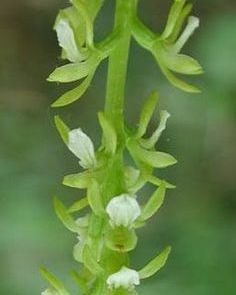Cirrhaea fuscolutea
(Cirrhaea fuscolutea)

Description
Cirrhaea is a genus with about seven species of sympodial epiphytic orchids. They are distributed in Brazil. A genus very close to Gongora and Polycycnis from which it differs in having a labellum with 3 lobes and a column. All species in this genus are epiphytes with a sympodial development. The roots are aerial, white and very fine, developing in dense bundles. Some roots develop upwards instead of hanging downwards. This specialization helps in the formation of large skeins of aerial roots. Many are found in association with nesting ants. The conical pseudobulbs are ribbed and about 8 cm long. Two alternate leaves are produced at the apex of each pseudobulb. The leaves are leathery and with pronounced veins, reaching up to 30 cm in length. The inflorescences are in clusters developing from the base of the pseudobulbs. The stems first grow upwards, but soon bend and become pendulous. The numerous flowers develop looking downwards, with the labellum upwards. The almost circularly bent pedicel is characteristic of this genus. They have two lateral sepals and one dorsal sepal. The flowers of several species are waxy. The fragrances are different in each species. The pollinia are superimposed on a stipe (a stack of cellular pollinia), which is collected by a viscidiumdisk-shaped. The flowers are pollinated by the male of the euglossine bees. They bloom between March and June. Cirrhaea species do well in a 3:1 mixture of fine-grained pine bark and sphagnum moss, but are less vigorous growers than Gongora. Depending on the low temperatures, watering should be reduced, but without causing the pseudobulbs to wrinkle too much. The genus Cirrhaea is closely related to Stanhopea, Gongora, Coryanthes, and Peristeria.
Taxonomic tree:







